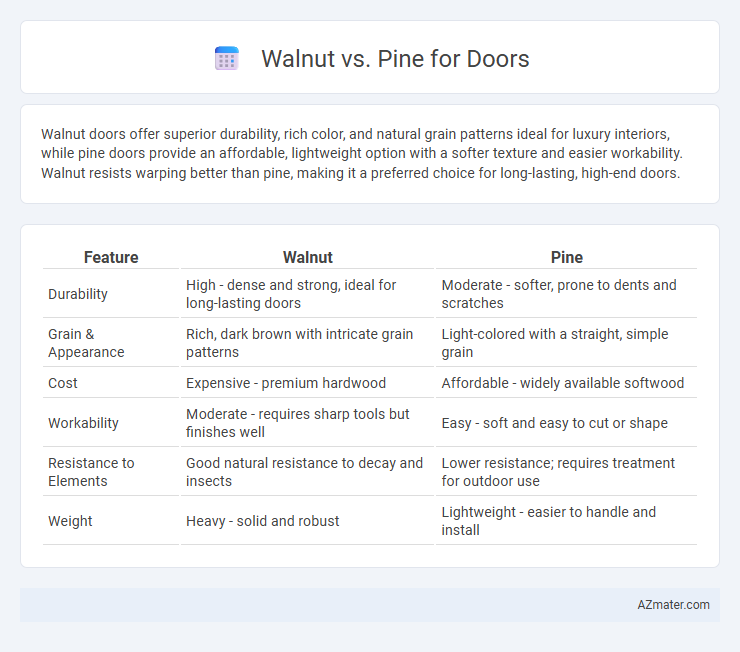Walnut doors offer superior durability, rich color, and natural grain patterns ideal for luxury interiors, while pine doors provide an affordable, lightweight option with a softer texture and easier workability. Walnut resists warping better than pine, making it a preferred choice for long-lasting, high-end doors.
Table of Comparison
| Feature | Walnut | Pine |
|---|---|---|
| Durability | High - dense and strong, ideal for long-lasting doors | Moderate - softer, prone to dents and scratches |
| Grain & Appearance | Rich, dark brown with intricate grain patterns | Light-colored with a straight, simple grain |
| Cost | Expensive - premium hardwood | Affordable - widely available softwood |
| Workability | Moderate - requires sharp tools but finishes well | Easy - soft and easy to cut or shape |
| Resistance to Elements | Good natural resistance to decay and insects | Lower resistance; requires treatment for outdoor use |
| Weight | Heavy - solid and robust | Lightweight - easier to handle and install |
Introduction to Walnut and Pine for Doors
Walnut is a dense hardwood known for its rich, dark brown color and fine, straight grain, making it a premium choice for high-end doors that require durability and elegance. Pine, a softwood with a pale yellow to light brown hue, offers affordability and ease of workability, commonly used in doors where cost-efficiency and versatility are prioritized. Both woods serve distinct aesthetic and functional purposes in door construction, with walnut providing a luxurious finish and pine delivering practical performance.
Appearance and Aesthetics Comparison
Walnut doors exhibit a rich, deep brown color with intricate grain patterns that enhance luxury and sophistication in interior design. Pine doors offer a lighter, pale yellow tone with visible knots, providing a rustic and casual aesthetic ideal for country or farmhouse styles. Choosing between walnut and pine depends on the desired visual impact and the existing decor, with walnut emphasizing elegance and pine promoting warmth and natural charm.
Durability and Strength Differences
Walnut offers superior durability and strength compared to pine, making it a preferred choice for high-quality doors that require long-lasting resilience. Pine is a softer wood that is more prone to dents and scratches, thus requiring more maintenance and care over time. The dense grain structure of walnut enhances its resistance to wear and warping, providing better protection in high-traffic areas.
Cost and Affordability Factors
Walnut doors typically cost significantly more than pine doors due to the hardwood's density, rich grain patterns, and durability, making walnut a premium choice for high-end interiors. Pine doors offer affordability and versatility with lower material and manufacturing expenses, making them a budget-friendly option for homeowners. When balancing cost and aesthetic appeal, pine provides an economical solution while walnut commands a higher price point reflecting its luxury status.
Maintenance and Care Requirements
Walnut doors require moderate maintenance with periodic oiling or waxing to preserve their rich color and prevent drying, while pine doors need more frequent treatment to protect against dents, scratches, and moisture damage due to their softer wood nature. Pine is prone to warping and requires sealing or painting to maintain durability, whereas walnut's natural oil content makes it more resistant to environmental changes but still benefits from regular dusting and polishing. Both woods demand attention to humidity levels, but pine typically needs more intensive care to maintain its appearance over time.
Environmental Impact and Sustainability
Walnut doors typically have a higher environmental impact due to slower growth rates and limited availability compared to pine, which is a fast-growing softwood often sourced from sustainably managed plantations. Pine's rapid renewability and carbon sequestration make it a more sustainable choice for eco-conscious consumers seeking low-impact materials. However, carefully certified walnut from well-managed forests can still contribute to responsible forestry practices while offering durability and aesthetic value.
Workability and Installation Ease
Walnut offers superior workability due to its fine, straight grain and smooth texture, making it easier to shape and finish for door applications. Pine is softer and more pliable, allowing quicker installation but requiring careful handling to prevent dents and scratches. The dense hardwood of walnut provides a more durable door frame, while pine's lighter weight simplifies transport and fitting during installation.
Suitability for Indoor vs Outdoor Doors
Walnut doors offer superior durability and rich aesthetics, making them ideal for indoor use where moisture exposure is minimal. Pine, being softer and more prone to weathering, generally suits outdoor doors better when treated with protective finishes to withstand varied climates. For indoor doors, walnut's stability and fine grain provide a premium look, while pine's affordability and ease of maintenance favor outdoor installation with proper sealing.
Sound Insulation and Thermal Properties
Walnut doors offer superior sound insulation due to their dense, hardwood structure, effectively reducing noise transmission compared to the softer, less dense pine. In terms of thermal properties, walnut has better natural insulating capabilities, helping maintain indoor temperatures and energy efficiency more effectively than pine. Pine doors, while lighter, are more porous and provide less thermal resistance and soundproofing performance.
Final Recommendation: Walnut or Pine for Your Door
Walnut offers superior durability, rich color, and natural resistance to wear, making it an excellent choice for high-end, long-lasting doors. Pine, being lighter and more affordable, is suitable for interior doors with less exposure to heavy wear or moisture. Choose walnut if you prioritize elegance and longevity; select pine for budget-friendly, easily paintable options.

Infographic: Walnut vs Pine for Door
 azmater.com
azmater.com